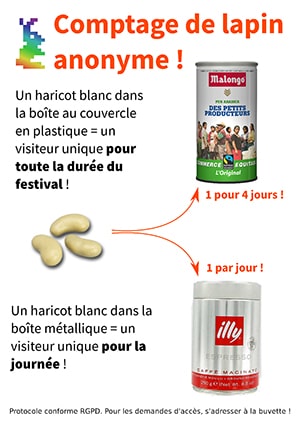Go further in the approach
Think offline
Providing offline reading or designing offline-first can reduce data transfer while maintaining access to content to locations that might not have good internet access.
Progressive Web Apps, by caching content on the smartphone, provides a similar experience to an application with a weight that is 10 times less. Of course, it is still necessary to optimize the cached content to use the phone memory and the bandwidth as little as possible during the download on the first connection.
- Mapeo, a map in the middle of anywhere, Digital Democracy - Mapeo
- Return on experience of the creation of a PWA for Ghanian students: Une application qui sauve des vies… et change la nôtre (in French)
De-digitize, re-materialize
Sometimes the best solution to reduce the environmental impact can be non-digital!
This requires in-depth reflection, a lot of creativity and above all an assessment of the advantages and disadvantages of an “analog” solution compared to a digital solution.
Non-digital solution example
The organizers of the “Pas sage en Seine” conference, which is free and open without registration, have set up an “anonymous rabbit count” to measure the number of participants.
This count is done with a recycled coffee pot and beans placed at the entrance to the conference venue.

They thought about it
Eco-design, like any design practice, boils down to a case-by-case assessment of the designer and we hope that this guide will offer you a toolbox among which you can pick new practices.
If you wish to learn more about eco-design, we recommend you to follow the works of the designers below:
- Marie-Cécile Godwin-Paccard: with her collective Common Future(s), she proposed a new approach called Anthropocene Design, based on new design assumptions and setting ethical limits.
See: her conference "Design for an unknown future" - Geoffrey Dorne: Striving to minimize his impact as much as possible, he offers an extensive approach to frugal innovation, to which he combines the inclusion of other species’ well-being (cognitive overload, light pollution bothering night species…).
See: his website (in French only) - Alexandre Monnin, Emmanuel Bonnet and Diego Landivar: they advocate for desinnovation, the renunciation to already obsolete projects which are fundamentally irreconcilable with the current environmental stakes, and offer to advise organisations on how to find their place in tomorrow’s world.
To read: their article "What the Anthropocene does to organizations"
To discover: their research lab Origens Media Lab (in French only) - Gauthier Roussilhe: between the eco-design of digital services and research on these topics, he tackles the eco-design topics with a holistic point of view (combining design and technical aspects) and a long-term vision (he considers local, materialized and resilient digital technologies).
See: his website
The summaries of their work are far too short to do them justice. Each of their approaches could be the topic of a full dedicated article on its own. We invite you to check their conferences, articles, podcasts, and books!
Don’t hesitate to contact us to share your comments and contribute to the evolution of this guide.
Thanks to all of you who contributed to making eco-design an evolving topic. Please continue to share your research and pertinent information within your different communities!
Examples of eco-designed websites
We have made a selection of eco-designed websites, but this list is by no means exhaustive. To avoid redundancy, we have chosen not to include all the websites of organizations specialized in sustainable technologies.
Content websites
- Low-tech Lab – Home
- Low←Tech Magazine
- № 1 · Politiques des communs
- Branch: A Sustainable Internet for All
Public websites
Product websites
Showcase websites
- rights4children: Children's rights in England
- La Boutique du Partage - lieu dédié au don et au partage d'objets
- Kaïros Sailing - Ecurie de course : projets sportifs ou responsables
- La Coopérative des Internets - Agence digitale responsable à Lyon
- Fairness - Concevoir responsable
A few ressources
Eco-design and digital sustainability
- Ecometer best practices
- Sustainable web design
- Designing Branch: Sustainable Interaction Design Principles
- 17 ways to make your website more energy efficient
- Gauthier Roussilhe: Writings
- The Green Pages
- Permaculture for websites: sustainable growth
- Design Sustainably | Designsustainably.eu
- Mightybytes | Sustainability
Resources in French
- Ecoconception / Les 115 bonnes pratiques- 3ème édition
- Boîte à outils - Collectif Conception responsable de service numérique
- Checklist de bonnes pratiques - Collectif GreenIT
- Qualité Web : la checklist de référence - Opquast
- Livre blanc GreenConcept 2020
- Livre blanc - l’éco-conception de services numériques
- Faire un site low tech - Low-tech lab
- Ressources - numérique éco-responsable
- Situer le numérique, Gauthier Roussilhe
- Hors-série Kaizen + Zenika - Numérique Responsable
- Numérique plus responsable : que dit la loi ?
- Le bon digital - Le numérique plus responsable
- Sobriété numérique : les clés pour agir, Frédéric Bordage
- L'âge des low tech, Philippe Bihouix
- Le guide d'un numérique plus responsable, Bela Loto Hiffler
Environmental footprint of technologies
- Environmental footprint of the digital world, GreenIT.fr, 2019
- "Lean ICT: Towards Digital Sobriety": Our new report, The Shift Project, 2018
Resources in French
- Impact environnemental du numérique et gouvernance de la 5G, The Shift Project, 2021
- Impacts environnementaux du numérique en France, GreenIT.fr, 2020